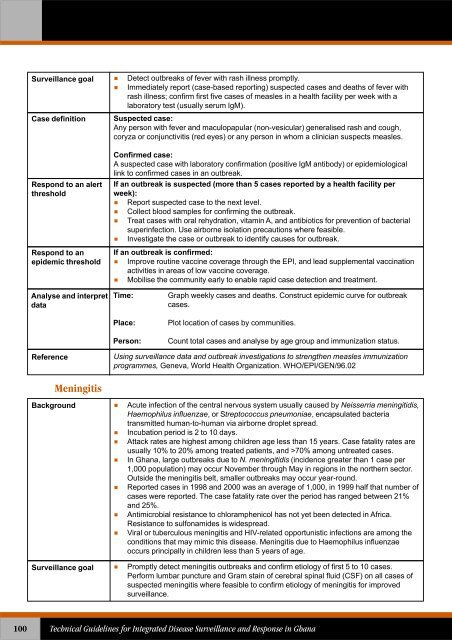Technical Guidelines for Integrated Disease Surveillance ... - PHRplus
Technical Guidelines for Integrated Disease Surveillance ... - PHRplus
Technical Guidelines for Integrated Disease Surveillance ... - PHRplus
You also want an ePaper? Increase the reach of your titles
YUMPU automatically turns print PDFs into web optimized ePapers that Google loves.
<strong>Surveillance</strong> goal Detect outbreaks of fever with rash illness promptly. Immediately report (case-based reporting) suspected cases and deaths of fever withrash illness; confirm first five cases of measles in a health facility per week with alaboratory test (usually serum IgM).Case definitionSuspected case:Any person with fever and maculopapular (non-vesicular) generalised rash and cough,coryza or conjunctivitis (red eyes) or any person in whom a clinician suspects measles.Respond to an alertthresholdRespond to anepidemic thresholdAnalyse and interpretdataConfirmed case:A suspected case with laboratory confirmation (positive IgM antibody) or epidemiologicallink to confirmed cases in an outbreak.If an outbreak is suspected (more than 5 cases reported by a health facility perweek): Report suspected case to the next level. Collect blood samples <strong>for</strong> confirming the outbreak. Treat cases with oral rehydration, vitamin A, and antibiotics <strong>for</strong> prevention of bacterialsuperinfection. Use airborne isolation precautions where feasible.Investigate the case or outbreak to identify causes <strong>for</strong> outbreak.If an outbreak is confirmed: Improve routine vaccine coverage through the EPI, and lead supplemental vaccinationactivities in areas of low vaccine coverage.Mobilise the community early to enable rapid case detection and treatment.Time:Graph weekly cases and deaths. Construct epidemic curve <strong>for</strong> outbreakcases.Place:Person:Plot location of cases by communities.Count total cases and analyse by age group and immunization status.ReferenceUsing surveillance data and outbreak investigations to strengthen measles immunizationprogrammes, Geneva, World Health Organization. WHO/EPI/GEN/96.02MeningitisBackground Acute infection of the central nervous system usually caused by Neisserria meningitidis,Haemophilus influenzae, or Streptococcus pneumoniae, encapsulated bacteriatransmitted human-to-human via airborne droplet spread. Incubation period is 2 to 10 days. Attack rates are highest among children age less than 15 years. Case fatality rates areusually 10% to 20% among treated patients, and >70% among untreated cases. In Ghana, large outbreaks due to N. meningitidis (incidence greater than 1 case per1,000 population) may occur November through May in regions in the northern sector.Outside the meningitis belt, smaller outbreaks may occur year-round. Reported cases in 1998 and 2000 was an average of 1,000, in 1999 half that number ofcases were reported. The case fatality rate over the period has ranged between 21%and 25%. Antimicrobial resistance to chloramphenicol has not yet been detected in Africa.Resistance to sulfonamides is widespread. Viral or tuberculous meningitis and HIV-related opportunistic infections are among theconditions that may mimic this disease. Meningitis due to Haemophilus influenzaeoccurs principally in children less than 5 years of age.<strong>Surveillance</strong> goal Promptly detect meningitis outbreaks and confirm etiology of first 5 to 10 cases.Per<strong>for</strong>m lumbar puncture and Gram stain of cerebral spinal fluid (CSF) on all cases ofsuspected meningitis where feasible to confirm etiology of meningitis <strong>for</strong> improvedsurveillance.100<strong>Technical</strong> <strong>Guidelines</strong> <strong>for</strong> <strong>Integrated</strong> <strong>Disease</strong> <strong>Surveillance</strong> and Response in Ghana















